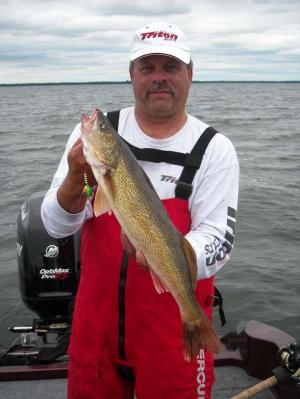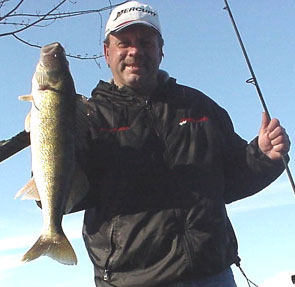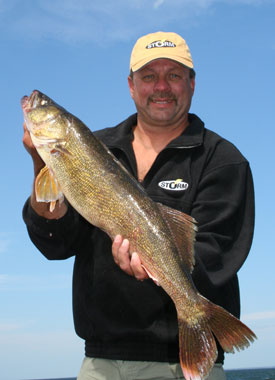 For much of the walleye season on our Midwestern rivers, anglers get locked into fishing conventional patterns in traditional locations. We go with the flow, fishing community holes where somebody is always going in the wrong direction, but we can usually count on picking up a few fish.
For much of the walleye season on our Midwestern rivers, anglers get locked into fishing conventional patterns in traditional locations. We go with the flow, fishing community holes where somebody is always going in the wrong direction, but we can usually count on picking up a few fish.
October is time to break away. With cooler water temperatures and transitioning walleyes that eat like Joey Chestnut, a proactive, run-and-gun approach will often put more and better fish in the boat.
Why fight a dozen other boats as they troll crankbaits across a sand flat? Why play bumper boats below a lock and dam? Why race up and down a river trying to get on your favorite wingdams only to find another angler anchored up, eating a sandwich and listening to a football game?
Why share a limited number of catchable fish when you can find walleyes that you can have to yourself? And why not do it your way?
For me, that means fishing with a rod in my hand as opposed to a rod holder. It means casting jigs and crankbaits to structure. And it usually means some jarring strikes and bullish battles with some of the largest ‘eyes in the system.
The environmental deck is stacked in our favor as the days become shorter and the trees begin to take on their autumn color.
Foremost, walleyes are aggressive and hungry as they build reserves for the coming winter. They’ll be active more often throughout a day and forage for longer periods of time.
Meanwhile, our rivers are typically running at low levels and water clarity is at its best. Low flow reduces the number of areas where walleyes will concentrate and makes it easier to read the current breaks and eddies they favor. High visibility means they’ll be able to identify and react to our jigs and crankbaits from a distance.
Ultimately, many fall walleyes will end up in the tailwaters below the locks and dams on systems like the Mississippi, Missouri and Wisconsin rivers. However, there isn’t any rush to get there, and some of the best angling can often be found miles below these barriers.
Rip-rapped shorelines are a great place to start. Big boulders provide ideal ambush points for walleyes where they don’t have to fight the flow and can lie in wait for the current to deliver their dinner. When the sun is shining, those rocks retain heat and attract baitfish. And when the wind is blowing into a stretch of rip-rap, it dislodges some of the aquatic life that the minnows, shad and chubs walleyes seek can feed upon.
 Two features make some rip-rap better than others.
Two features make some rip-rap better than others.
Look for rock shorelines that drop sharply into water 10 feet or deeper. These stretches provide shallow water where walleyes can slide up to find an easy meal and the security of deeper water that will keep them in the area. They give an angler the bonus of fishing the shallower shelf to pick off the most active fish, then probing the break for additional walleyes.
Look, too, for sections that are directly exposed to current, which creates pockets of slack water or eddies where fish can also rest comfortably while their food is catered by the river. The top of these stretches seem to produce best.
Inside and outside bends in the river channel are also good locations to find October walleyes because they also create current breaks that walleyes favor. Look for turns with a hard bottom such as sand, gravel or rock.
Sandbars are another of my favorite locations. While many are extremely shallow on top, they usually feature edges where they fall sharply into deeper water and provide additional places that hold walleyes.
The mouths of feeder creeks can’t be overlooked, either. The convergence of different currents creates eddies and these areas often feature submerged stumps or logs where walleyes can rest.
All of these areas will hold fish for extended periods. Some live there year-round. Others are passing through. Either way, they are there for reasons related to food and comfort.
It’s like a cornfield that consistently attracts migrating ducks and geese. Even when one group leaves, another usually moves in behind it.
Whether you are casting cranks or pitching jigs, it’s critical to visualize your lure at work beneath the surface. Make is appear as natural as possible, which means casting upstream and working it downstream like a baitfish being carried by the current to fish that are positioned upstream to intercept it. Fishing a bait across or against the current isn’t as natural this time of year.
In most of the rivers I fish, it’s hard to beat a Shad Rap with its tight wobble and natural appearance. The No. 5 Rattlin’ Shad Rap casts like a bullet in nearly any conditions and I like the way they work across rock, bumping the edges but seldom hanging up. I’ve also had good success with No. 5 Glass Shad Raps, and a No. 7 is a good option when you need to get just a bit deeper.
 Jig fishing is more related to weather fronts and the mood of the walleyes. Sometimes, during cold fronts, high pressure systems or sudden changes in their environment, walleyes just don’t respond as well as I’d like to a crankbait. Then I turn to hair jigs, short-shanked jigs tipped with live bait or jigs dressed with plastics.
Jig fishing is more related to weather fronts and the mood of the walleyes. Sometimes, during cold fronts, high pressure systems or sudden changes in their environment, walleyes just don’t respond as well as I’d like to a crankbait. Then I turn to hair jigs, short-shanked jigs tipped with live bait or jigs dressed with plastics.
I usually start with a Fin-Tech jig head tipped with a 3- or 4-inch Kalin grub tail. It’s a durable presentation and eliminates the need to handle live bait. There are times, however, when the subtle action of a hair jig triggers more strikes and other times when a slowly fished leadhead tipped with a minnow or a piece of crawler is the best presentation.
Mix it up when you’ve got company in the boat. If I’m fishing a Shad Rap, my partner is working a jig. If we’re both fishing jigs, we’re trying different combinations to see what the walleyes want on a particular day.
Vary your retrieves to learn how a fish wants a bait on a given day. With crankbaits, start with a straight, steady retrieve, but don’t hesitate to try a stop-and-go technique where you let your lure pause for a couple of seconds. That can be deadly for indecisive fish.
With jigs, a gentle lift-drop technique is usually best while letting the current do most of the work, but don’t rule out an aggressive snap-jigging approach or a straight retrieve with plastics when the lift-drop doesn’t seem to be getting it done. Sometimes, I’ve had to adjust my jigging stroke midway through the day to stay hooked up.
Most of these October river locations can be fished fairly quickly. If there are active walleyes in the area, they will usually let you know. I use my MinnKota Terrova 101 to keep my boat positioned off the structure I’m fishing, but I let the current move me downstream as I work over a section of water.
Another reason I like a run-and-gun approach to autumn fishing is the presence of other species of gamefish. You may well encounter largemouth bass, smallmouth bass, white bass, northern pike, muskies, crappies, perch, catfish and possibly even an occasional platter-sized bluegill. Seldom is the day when you don’t hook up with something exciting on these outings.
Give it a try. Get away from the crowd and do your own thing. You’ll like the results.










